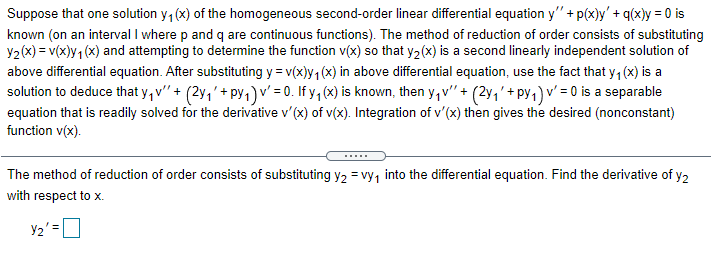Suppose that one solution y, (x) of the homogeneous second-order linear differential equation y" +p(x)y´ + q(x)y = 0 is known (on an interval I where p and q are continuous functions). The method of reduction of order consists of substituting 2(x) = v(x)y1 (x) and attempting to determine the function v(x) so that y2(x) is a second linearly independent solution of above differential equation. After substituting y = v(x)y, (x) in above differential equation, use the fact that y, (x) is a solution to deduce that y, v" + (2y,' + py,) v' = 0. If y, (x) is known, then y,v" + (2y,'+ py,) v' = 0 is a separable equation that is readily solved for the derivative v'(x) of v(x). Integration of v'(x) then gives the desired (nonconstant) function v(x). ) oft The method of reduction of order consists of substituting y, = vy, into the differential equation. Find the derivative of y2 with respect to x.
Suppose that one solution y, (x) of the homogeneous second-order linear differential equation y" +p(x)y´ + q(x)y = 0 is known (on an interval I where p and q are continuous functions). The method of reduction of order consists of substituting 2(x) = v(x)y1 (x) and attempting to determine the function v(x) so that y2(x) is a second linearly independent solution of above differential equation. After substituting y = v(x)y, (x) in above differential equation, use the fact that y, (x) is a solution to deduce that y, v" + (2y,' + py,) v' = 0. If y, (x) is known, then y,v" + (2y,'+ py,) v' = 0 is a separable equation that is readily solved for the derivative v'(x) of v(x). Integration of v'(x) then gives the desired (nonconstant) function v(x). ) oft The method of reduction of order consists of substituting y, = vy, into the differential equation. Find the derivative of y2 with respect to x.
Calculus: Early Transcendentals
8th Edition
ISBN:9781285741550
Author:James Stewart
Publisher:James Stewart
Chapter1: Functions And Models
Section: Chapter Questions
Problem 1RCC: (a) What is a function? What are its domain and range? (b) What is the graph of a function? (c) How...
Related questions
Question

Transcribed Image Text:Suppose that one solution y, (x) of the homogeneous second-order linear differential equation y" + p(x)y'+ q(x)y = 0 is
known (on an interval I where p and q are continuous functions). The method of reduction of order consists of substituting
Y2(x) = v(x)y1 (x) and attempting to determine the function v(x) so that y2(x) is a second linearly independent solution of
above differential equation. After substituting y = v(x)y, (x) in above differential equation, use the fact that y, (x) is a
solution to deduce that y, v" + (2y,'+ py,)v' = 0. If y, (x) is known, then y,v'" + (2y,'+ py,) v' = 0 is a separable
equation that is readily solved for the derivative v' (x) of v(x). Integration of v'(x) then gives the desired (nonconstant)
function v(x).
The method of reduction of order consists of substituting y2 = vy, into the differential equation. Find the derivative of y2
with respect to x.
Y2' =D
Expert Solution
This question has been solved!
Explore an expertly crafted, step-by-step solution for a thorough understanding of key concepts.
This is a popular solution!
Trending now
This is a popular solution!
Step by step
Solved in 2 steps with 1 images

Recommended textbooks for you

Calculus: Early Transcendentals
Calculus
ISBN:
9781285741550
Author:
James Stewart
Publisher:
Cengage Learning

Thomas' Calculus (14th Edition)
Calculus
ISBN:
9780134438986
Author:
Joel R. Hass, Christopher E. Heil, Maurice D. Weir
Publisher:
PEARSON

Calculus: Early Transcendentals (3rd Edition)
Calculus
ISBN:
9780134763644
Author:
William L. Briggs, Lyle Cochran, Bernard Gillett, Eric Schulz
Publisher:
PEARSON

Calculus: Early Transcendentals
Calculus
ISBN:
9781285741550
Author:
James Stewart
Publisher:
Cengage Learning

Thomas' Calculus (14th Edition)
Calculus
ISBN:
9780134438986
Author:
Joel R. Hass, Christopher E. Heil, Maurice D. Weir
Publisher:
PEARSON

Calculus: Early Transcendentals (3rd Edition)
Calculus
ISBN:
9780134763644
Author:
William L. Briggs, Lyle Cochran, Bernard Gillett, Eric Schulz
Publisher:
PEARSON

Calculus: Early Transcendentals
Calculus
ISBN:
9781319050740
Author:
Jon Rogawski, Colin Adams, Robert Franzosa
Publisher:
W. H. Freeman


Calculus: Early Transcendental Functions
Calculus
ISBN:
9781337552516
Author:
Ron Larson, Bruce H. Edwards
Publisher:
Cengage Learning